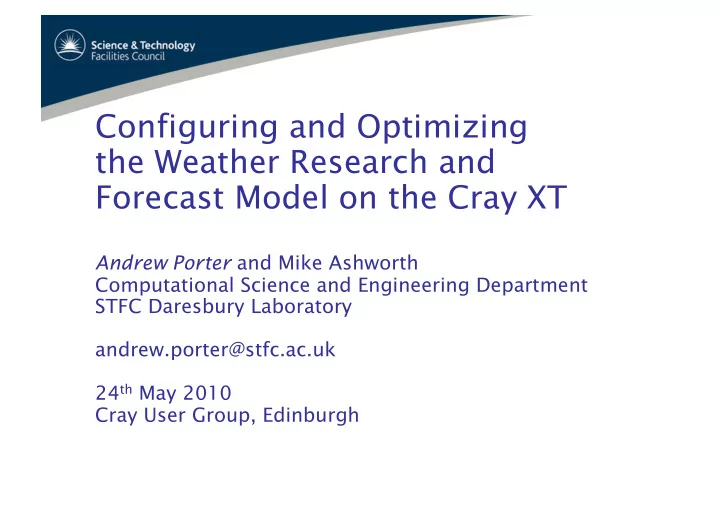

Configuring and Optimizing the Weather Research and Forecast Model on the Cray XT Andrew Porter and Mike Ashworth Computational Science and Engineering Department STFC Daresbury Laboratory andrew.porter@stfc.ac.uk 24 th May 2010 Cray User Group, Edinburgh
Overview • Introduction • Machines • Benchmark Configuration • Choice of Compiler/Flags • MPI Versus Mixed Mode (MPI/OpenMP) • Memory Bandwidth Issues • Tuning Cache Usage • Input/Output • Default scheme • pNetCDF • I/O servers & process placement
Introduction - WRF • Regional- to global-scale model for research and operational weather- forecast systems • Developed through a collaboration between various US bodies (NCAR, NOAA...) • Finite difference scheme + physics parametrisations • F90 [+ MPI] [+ OpenMP] • 6000 registered users (June 2008)
Introduction – this work • WRF accounts for significant fraction of usage of UK national facility (HECToR) • Aim here is to investigate ways of ensuring this use is efficient • Mainly through (the many) configuration options • Code optimization when/if required
Machines Used • HECToR – UK national academic supercomputing service – Cray XT4 – 1x AMD Barcelona 2.3GHz quad-core chip per compute node – SeaStar2 interconnect • Monte Rosa – Swiss National Supercomputing Service (CSCS) – Cray XT5 – 2x AMD Istanbul 2.4GHz hexa-core chips per compute node – SeaStar2 interconnect
Benchmark Configuration “Great North Run” Three nested domains with two-way feedback between them: D1 = 356 x 196 D2 = 319 x 322 D3 = 391 x 328 D3 gives 1Km- resolution data over Northern England.
Choice of Compiler/Flags HECToR offers four different compilers! Portland Group (PGI) Pathscale (recently bought by Cray) Cray Gnu (gcc + gfortran) WRF can be built in serial, shared- memory (sm), distributed-memory (dm) and mixed (dm+sm) modes...
Initial Compiler Comparison for dm (MPI) build
Effect of Extra Flags
Compiler notes I 1.1K -> 1.2K time-steps/wall-clock hour on 1024 cores from increasing optimization with PGI -O3 –fast to –O3 –fastsse –Mvect=noaltcode –Msmartalloc –Mprefetch=distance:8 -Mfprel 1.2K -> 1.3K by re-building to remove array init'n prior to each inter-domain feedback stage PS with extra optimization flags only very slightly slower than PGI Gnu (default) is 25% slower than PGI (default) on 256 cores but only 10% slower on 1024 Deficit much larger when extra optimization turned on for PGI
Verification of Results Compare T at 2m for 6 hr run of default & optimized binaries Max. diff is only ~0.1K
Mixed mode versus dm on XT4 and XT5
Compiler notes II PS dm+sm binary faster than PGI version dm+sm faster than dm on 512+ cores Reduced MPI communications Better use of cache WRF generally faster on 2.3 GHz quad- core XT4 than on 2.4 GHz hexa-core XT5 Only dm+sm version comes close to overcoming the difference
Under-populating XT5 nodes • De-populating steadily reduces time in both user and MPI code • Rate of cache fills for user code steadily increases: ‘memory wall’
Improving cache usage Efficient use of large, on-chip memory cache is very important in getting high performance from x86-type chips Under MPI, WRF gives each process a 'patch' to work on. These patches can be further decomposed into 'tiles' (used by the OpenMP implementation) e.g . decomposition of domain into four patches with each patch containing six tiles:
Performance variation with tiling
Notes on tiling performance Most effect on low core-count jobs because these have large patches and thus large array extents In this case, still get ~5% speed-up by using four tiles for both 512- and 1024- core MPI jobs HWPC data shows that improvement is largely due to better use of L2 ‘victim’ cache (20% hit rate => 70+% hit rate)
I/O Considerations • All benchmark results presented so far carefully exclude effects of doing I/O • But, MUST write data to file for job to be scientifically useful… • Data written as ‘frames’ – a snapshot of the system at a given point in time – One frame for GNR is ~1.6GB in total but this is spread across 3 files (1 per domain) and many variables
Approaches to I/O in WRF • Default: data for whole model domain gathered on ‘master’ PE which then writes to disk • All PEs block while master is writing • Does not scale • Memory limitations
Parallel netCDF (pNetCDF) • Uses the pNetCDF library from Argonne • Every PE writes • Current method of last resort when domain won’t fit into memory of single PE – Will become more of a problem as model sizes and numbers of cores/socket increase • Slow – Lots of small writes – e.g . 256-core job, mean time to write domain 3 with default method = 12s. Increases to 103s with parallel netCDF!
I/O Quilting • Use dedicated ‘I/O servers’ to write data • Compute PEs free to continue once data sent to I/O servers • No longer have to block while data is sent to disk • Number of I/O servers may be tuned to minimise time to gather data • Only ‘master’ I/O server currently writes – Domain must still fit into memory
Process mapping Compute process I/O process MPI Communicator I/O • How best to assign compute PEs to I/O servers? • By default, all I/O servers end up grouped together on a few compute nodes
I/O quilting performance
Effect of process mapping
Conclusions PGI best for dm build, PS for sm+dm sm+dm scales best; performs much better than dm on fatter nodes of XT5 Less MPI communication Better cache usage Codes like WRF that are memory- bandwidth bound are not well-served by proliferation of cores/socket I/O quilting reduces time lost to I/O and is insensitive to process placement/mapping
Acknowledgements • EPSRC and NAG, UK for funding • Alan Gadian, Ralph Burton (University of Leeds) and Michael Bane (University of Manchester) for project direction • John Michelakes (NCAR) for problem- solving assistance and advice andrew.porter@stfc.ac.uk
Recommend
More recommend